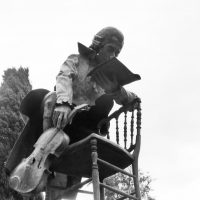
Numerous experiments have shown that the right hemisphere dominates the first 2 to 3 years of a child’s life. A child has a vital need for holistic perception, it needs to ‘grab’ objects and phenomena of the outside world so as to define them as either attractive or dangerous. It is the right hemisphere which ensures emotional contact with the mother, catching the facial expressions which express her attitude to her child. Her attitude is perceived in the most general terms – acceptance or non-acceptance. A newborn baby can already recognise its mother’s voice by the fourth day. Until ten months it can distinguish between intonations in the voice even better than an adult. It has been shown that the actual connections between the neurons in the right hemisphere are formed under the influence of emotional contact with the mother. The ability to understand speech at an elementary level is already developing at this early stage of right-hemisphere dominance.
Between the ages of 3 and 5 we begin to see the gradual development of the mechanisms of the left hemisphere, especially of the temporal lobe, which is responsible for speech. Not only do we see further development in the understanding and production of complex verbal expressions, but also the earliest signs of formation of the conditions for verbal-logical thinking. This process is a lengthy one. It is stimulated further by learning at school and culminates with the maturity of the left frontal lobe, responsible for the creation of monosemantic context and analytical thinking.
Naturally, development continues, too, in the various structures of the right hemisphere which are responsible for spatial orientation, perception of sounds and images, and gracefulness of movement.
The development of the anterior (frontal) sections of both left and right hemispheres is a long and complex process, but it is especially prolonged in the right frontal structures, and in the final stage of maturation they become dominant. Interestingly, the formation of the right frontal lobe takes longer in men than in women, and quite often it does not reach full maturity in men until they are in their forties. It is because of this lengthy maturing process of the right frontal lobe that adolescents, who in many respects, including their capacity for logical thought, appear at first glance no different from adults, often seem immature in terms of personality.
In recent years findings have emerged that connect the frontal lobe of the right hemisphere with such complex and uniquely human functions as the formation of the self-image, the integral, holistic image a person has of himself. This is so complex it cannot be broken down into constituent parts, nor can a person ever be fully cognizant of it. On the right frontal lobe depend the choice of behavioural alternatives in conflict situations; empathy; sense of humour; what has come to be known as the “theory of mind” – the ability to understand how others understand you; autobiographical episodic memory, which is closely connected with self-perception and based on visual-image memory; the ability to distinguish oneself from others, and, finally, the ability to solve problems creatively. In terms of their importance for an individual’s integration in the world, these functions are no less significant than those of the symmetrical parts of the left hemisphere (logical thought, determination of causal relationships), which always used to be considered the higher mental functions.
Until the recent discovery of the functions of the frontal sections of the right hemisphere I have just described, the significance of the right hemisphere’s return to dominance and the slower maturing of the brain’s right frontal sections remained a mystery. We also know that the later the brain structure achieves final maturity, the higher the level of its functional development.
Judging by this link between the length of maturation and the final level of development, the anterior sections of the right hemisphere should be responsible for some of the highest mental functions, higher than the left’s verbal-logical thinking and speech, which were long thought to be the culmination of the brain’s development. All the functions of the right frontal structures I mentioned earlier, from the formation of the self-image to the creative solution of problems, are probably what comprise these higher mental functions, which are grouped together and generalised in my suggested concept by the notion of the polysemantic nature of right-hemisphere thinking.
It is also true that the prolonged development of the right frontal lobe increases its vulnerability – something which has not yet fully matured is more sensitive to harmful influences and trauma, whether physical or psychological. This might explain the greater deviation of mental development in men on either side of the average: the longer any structure takes to reach full maturity, the more vulnerable it is to damage. There may be a connection between this and the predominance of certain forms of psychopathology (schizophrenia, for example) in men compared to women. On the other hand, if there are no setbacks to the brain’s development, then the end result may be a higher level of development of the right frontal lobe in men. This, along with other factors, may be connected with having a vision of the world on a grand scale and powerful creative potential.
There is one important aspect that needs special attention. The holistic perception of objects and phenomena that infants are capable of at the earliest stages of development is not synonymous with polysemy.
Integrality is also determined by the instantaneous capture of a host of different internal connections between elements of reality. But it is only after the left hemisphere, responsible for the formation of monosemantic context, has completed its development that a polysemantic context can be formed. In other words, an integral, holistic state becomes polysemantic only by contrast with a monosemantic context.
The formation of a polysemantic context really does represent the highest integrative level of human mental functions. This fits in with the picture I have just described of the brain’s hemispheres maturing with age. The sequence in which they do it holds a very important psychological and philosophical point.
The early stages of growing up (ontogenesis) require an integral, holistic perception of the world, and also of the self as a natural and inseparable particle of this world, without reflection, solely in order to survive.
The second stage of development sees the formation of thought, bringing with it analysis and differentiation between phenomena and the creation of monosemantic models, which are easy to communicate and which ensure purposeful, conscious behaviour. At the same time, the child begins to see himself as separate from the world, develops reflection. Self-perception is impossible without this stage. But, simultaneously, the child loses the initial infantile sensation of oneness with the world, in which everything is simple: those nearest him love him, and if that is so, he feels happy and the world is interesting and non-hostile. Now comes the feeling of contrasting the self to a complex outside world.
And so, after this second stage is completed comes the necessity for the third upward twist of the spiral – synthesis. Standing distinct from the world and to a certain extent in opposition to it, an individual must feel that he still belongs to a holistic world, though at a completely different level now that he has come to understand his specificity and separateness.
This belonging is achieved by the creation of new relationships with the world in the framework of polysemantic contexts, which are in opposition to monosemantic contexts, but which incorporate the latter in certain particular instances. Thus, the polysemantic self-image includes within itself the I-concept as a particular instance, and yet is much more than that. A higher synthesis is at work here, and without it neither creativity nor the resolution of inner conflicts would be possible, nor, indeed, would that happy sense of being part of the world and in harmony with it, while yet feeling clearly a distinct personality. This is the unique property of a mature healthy person. It is what makes an adult different from an infant. He also feels that he belongs to the world, but on quite a different level, on the level of being one with the world, without a separate identity.
This feeling of belonging to the world of multiple meanings does not imply being dissolved in it, but rather the enrichment, as it were, of oneself at the expense of the world. This is a secondary integration with the world, but at a higher level. At the same time, detachment of the self from the world is an absolute precondition for the formation of the self-image as the psyche’s supreme authority. Further, the capacity for holistic perception of both present and past as well as orientation towards the future are possible only after the formation of the left-hemisphere marker of time and overcoming its limitations.
On the basis of the above, you might suppose that a polysemantic context clears the way for an extraordinarily free, wholly unrestrained manipulation of information, and can obtain an abundance of new connections between objects and phenomena. But this supposition is not supported by the findings of Professor Deglin mentioned in the chapter Behaviour and the Split Brain. These came from his research on depressive patients undergoing ECT during which either the left or right hemisphere was shut down. After verbal contact was restored following ECT, the patient was presented with the following false syllogism (and a number of other, similar ones): “Monkeys climb trees. Porcupines are monkeys. Can porcupines climb trees?”
In a control study before ECT, the subjects in most cases replied in the negative, basing themselves on reality and not on the false statement. After the left hemisphere was shut down, and with a relatively more functioning right, patients as a rule answered this question in the negative. The negative reply was accompanied by an emotional reaction, annoyance at the absurdity of the statement.
But when the right hemisphere was shut down, with a relatively more functioning left, the answer was in most cases positive. However, when asked directly – “Are porcupines really monkeys?”, they gave the correct answer – “No, they have spines, like a hedgehog”. When asked if porcupines could climb trees, again the patients gave a correct answer. But this only happened when the questions were taken out of the context of the syllogism and the identification of a porcupine with a monkey was posed as a question and not delivered as a statement.
If patients were presented with the same syllogism a few minutes later, they would answer: “A porcupine is a monkey, so it means it can climb trees”. To an objection such as: “But you know a porcupine isn’t a monkey” (or other such objections to similar false syllogisms) the patients’ replies were remarkably stereotyped: “That’s what it says on the card”.
This explanation was fully sufficient for the patient. In other words, there was no critical attitude towards the original statement. Professor Deglin notes that the patients were liberated, as it were, from their own past experience and knowledge, freed from the real relationships of things.
They were freed also from their own imagination and submitted only to the formal logic of the task. This was a special freedom, freedom from a polysemantic context while being totally dependent on the monosematic context of the instruction. Thanks to such a special freedom it is possible to ‘extract’ an object from the multiplicity of real connections and place it in an artificial milieu of impoverished connections and relations.
At the same time, the contradictions are not resolved, but ignored. Switching off the right hemisphere brings about such a ‘freedom’ from reality, and this may lead to the triumph of fiction over reality.
In the creative process, which is the subject of our next chapter, contradictions are not ignored.



